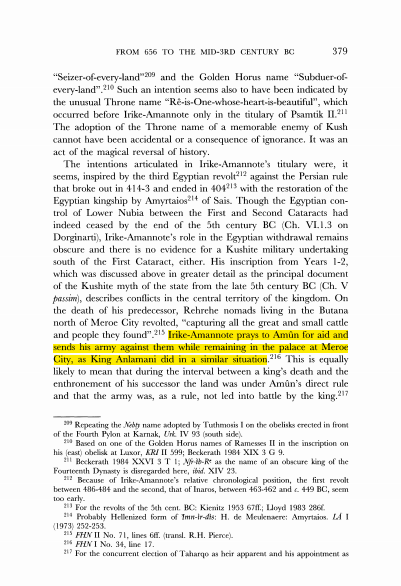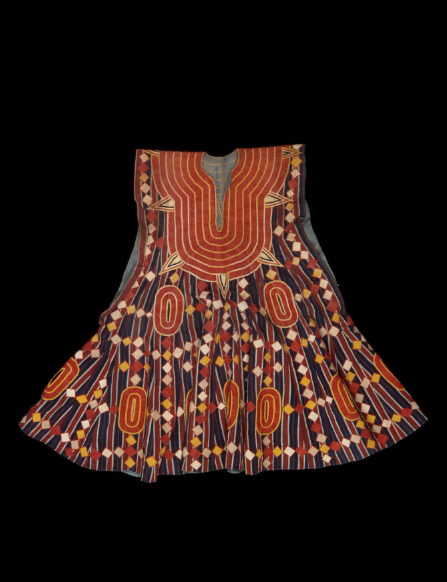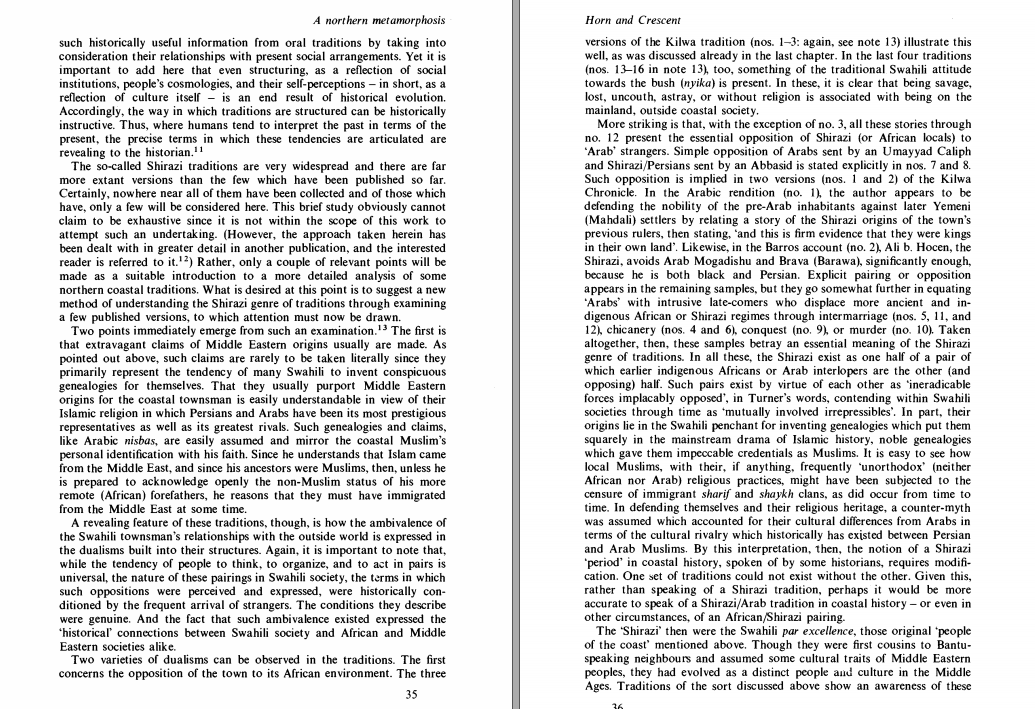
My article:
"The Meroitic empire, Queen Amanirenas and the Candaces of Kush: power and gender in an ancient African state"
On the enigma of Meroe
-Kush's defeat of Rome and its peace treaty
-The legacies of Queen Amanirenas and Queen Njinga
isaacsamuel.substack.com/p/the-meroitic…

"The Meroitic empire, Queen Amanirenas and the Candaces of Kush: power and gender in an ancient African state"
On the enigma of Meroe
-Kush's defeat of Rome and its peace treaty
-The legacies of Queen Amanirenas and Queen Njinga
isaacsamuel.substack.com/p/the-meroitic…


The city of Meroe has the most enigmatic history of all ancient societies
it was a scene of violent conflict b'tn the armies of Kush and unnamed groups, the home of a "heretic" King who destroyed the priesthood and the capital of a Queen who defeated Rome
isaacsamuel.substack.com/p/the-meroitic…
it was a scene of violent conflict b'tn the armies of Kush and unnamed groups, the home of a "heretic" King who destroyed the priesthood and the capital of a Queen who defeated Rome
isaacsamuel.substack.com/p/the-meroitic…
During Meroe's golden age, 7 of its 13 monarchs were women; two of whom immediately succeeded Queen Amanirenas
The peculiar circumstances in which 3 female sovereigns came to rule Kush in close succession was largely a consequence of Amanirenas's actions
isaacsamuel.substack.com/p/the-meroitic…
The peculiar circumstances in which 3 female sovereigns came to rule Kush in close succession was largely a consequence of Amanirenas's actions
isaacsamuel.substack.com/p/the-meroitic…

the Neolithic cultures from which the kingdom of Kush emerged (between 6000BC-3900BC) possessed a hierarchical structure of power where women occupied the highest position of leadership with the richest grave furnishings belonging to the burials of women
isaacsamuel.substack.com/p/the-meroitic…
isaacsamuel.substack.com/p/the-meroitic…
While no Queen regnants are mentioned from the little that is known about the empire of Kerma (the first era of Kush)
Two powerful Kerman queen consorts were diplomatically married to the 17th and 14th dynasties of Egypt (Thebes) and Hyksos
isaacsamuel.substack.com/p/the-meroitic…
Two powerful Kerman queen consorts were diplomatically married to the 17th and 14th dynasties of Egypt (Thebes) and Hyksos
isaacsamuel.substack.com/p/the-meroitic…

the region of lower Nubia was ruled by a Queen
of Meroitic extract named Katimala in the 10th century BC
she exercised full authority, convened a council of chiefs and reported about her military campaigns in which she led her armies from the front
isaacsamuel.substack.com/p/the-meroitic…
of Meroitic extract named Katimala in the 10th century BC
she exercised full authority, convened a council of chiefs and reported about her military campaigns in which she led her armies from the front
isaacsamuel.substack.com/p/the-meroitic…
Queen Katimala condemns her male predecessor's inability to secure the state and in a usurpation of royal prerogatives, she assumes military and royal authority after claiming that the king couldn't
her iconography antecedents the Meroitic Queens'
isaacsamuel.substack.com/p/the-meroitic…
her iconography antecedents the Meroitic Queens'
isaacsamuel.substack.com/p/the-meroitic…

Kush remerged as a powerful state set on conquering Egypt
inorder to achieve this the kings of Kush worked with their kinswomen by positioning the latter in priestly offices to legitimize their rule, elevating the power of the Queen mother and sister
isaacsamuel.substack.com/p/the-meroitic…
inorder to achieve this the kings of Kush worked with their kinswomen by positioning the latter in priestly offices to legitimize their rule, elevating the power of the Queen mother and sister
isaacsamuel.substack.com/p/the-meroitic…
Kush's succession was bilateral not matrilineal and the kinswomen's offices were an adaptation of Egyptian customs to integrate it into Kush's realm
despite this, these powerful kinswomen participated in royal customs that in Egypt were reserved for Kings
isaacsamuel.substack.com/p/the-meroitic…
despite this, these powerful kinswomen participated in royal customs that in Egypt were reserved for Kings
isaacsamuel.substack.com/p/the-meroitic…

The emergence of the "Meroitic dynasty" of Kush and the overthrow of the old royals is related in the story of "Ergamenes, ruler of the Aithiopians”
the account is mostly allegorical but matches with the transfer of the royal necropolis to Meroe in 270BC
isaacsamuel.substack.com/p/the-meroitic…
the account is mostly allegorical but matches with the transfer of the royal necropolis to Meroe in 270BC
isaacsamuel.substack.com/p/the-meroitic…
the "Meroitic dynasty" stressed its southern origins from Meroe, its southern gods Apedemak, Arensnuphis, and Sebiumeker and its new ideology and iconography of Kingship
all of which would become important for the Queens of Kush to ascended to the throne
isaacsamuel.substack.com/p/the-meroitic…
all of which would become important for the Queens of Kush to ascended to the throne
isaacsamuel.substack.com/p/the-meroitic…
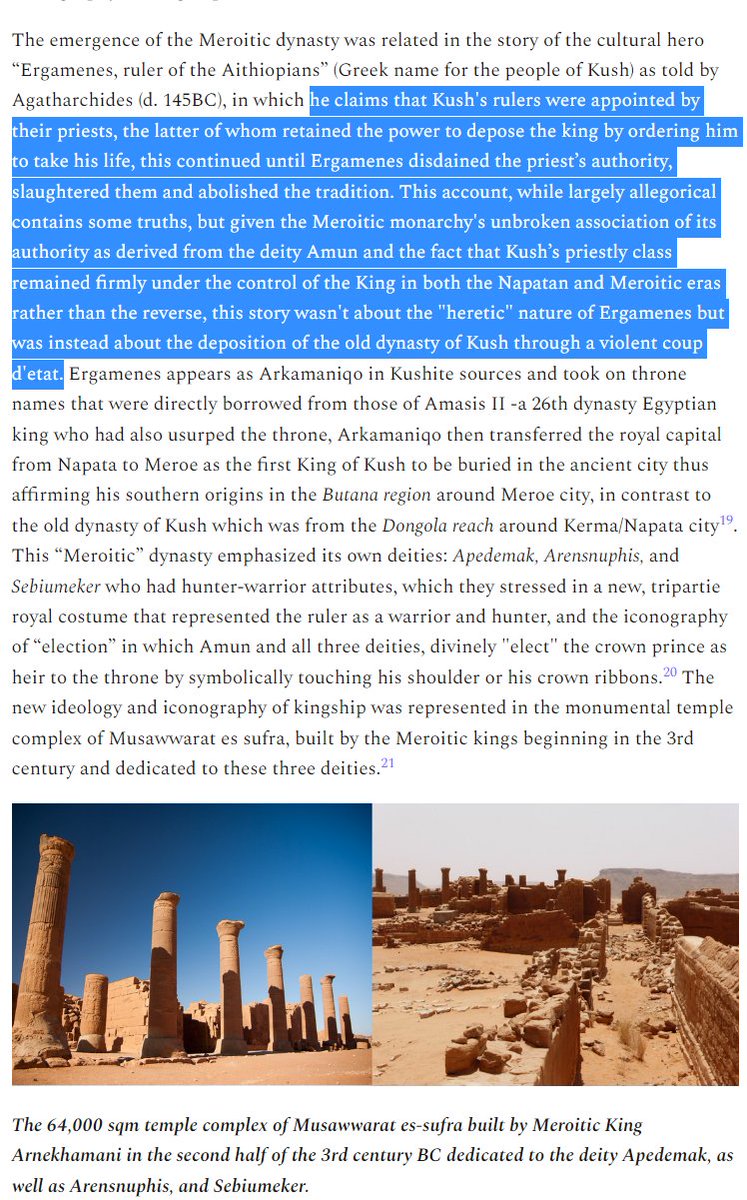
coinciding with the establishment of the Meroitic rulers in Kush were the incursions of the greek Ptolemaic dynasty of Egypt into lower Nubia
this region's control oscillated between Egypt and Kush for millennia but in 274BC it was conquered by the former
isaacsamuel.substack.com/p/the-meroitic…
this region's control oscillated between Egypt and Kush for millennia but in 274BC it was conquered by the former
isaacsamuel.substack.com/p/the-meroitic…
the meroitic Kings Arqamani and Adikhalamani reconquered lower Nubia from the ptolemies in 207BC and built temples, only to lose it in 186BC and regain it in 100BC until 30BC when the romans took it, intending to use it as a lauchpad to conquer all of Kush
isaacsamuel.substack.com/p/the-meroitic…
isaacsamuel.substack.com/p/the-meroitic…

The war b'tn Rome & Kush involved 3 battles of which 2 were led by Queen Amanirenas
-Kush supported rebellion in lower nubia that also involved the breaking of Augustus' statues
Kush's king Teriteqas then advanced north to reinforce them but died enroute
isaacsamuel.substack.com/p/the-meroitic…
-Kush supported rebellion in lower nubia that also involved the breaking of Augustus' statues
Kush's king Teriteqas then advanced north to reinforce them but died enroute
isaacsamuel.substack.com/p/the-meroitic…
Queen Amanirenas' 1st battle with Rome ended with the latter's victory
Rome marched south to conquer Kush but was defeated and retreated north
Amanirenas followed them north
Rome signs peace treaty
Amanirenas commissions paintings showing Rome's defeat
isaacsamuel.substack.com/p/the-meroitic…



Rome marched south to conquer Kush but was defeated and retreated north
Amanirenas followed them north
Rome signs peace treaty
Amanirenas commissions paintings showing Rome's defeat
isaacsamuel.substack.com/p/the-meroitic…




Rome's peace treaty favored Kush
Rome withdrew further north and removed the taxes placed on the rebels
Queen Amanirenas buried the severed bronze head of Augustus under a temple to trample on it and Kush's triumphant stele now showed roman captives
isaacsamuel.substack.com/p/the-meroitic…
Rome withdrew further north and removed the taxes placed on the rebels
Queen Amanirenas buried the severed bronze head of Augustus under a temple to trample on it and Kush's triumphant stele now showed roman captives
isaacsamuel.substack.com/p/the-meroitic…
its uncertain why Queen Amanirenas, a consort, succeeded over Akinidad the prince
but Akinidad would go on to legitimize Amanirenas' rule as well as her successor Queen Amanishakheto
four of the first Queens of Meroe were thus "elected" by princes
isaacsamuel.substack.com/p/the-meroitic…
but Akinidad would go on to legitimize Amanirenas' rule as well as her successor Queen Amanishakheto
four of the first Queens of Meroe were thus "elected" by princes
isaacsamuel.substack.com/p/the-meroitic…

while these four Queens (Shanakdakheto, Amanirenas, Amanishakheto and Nawidemak) were shown with male attributes of Kingship eg the royal costume and crown
their figures were feminine and employed a distinctively Meroitic motif with heavy-set bodies
isaacsamuel.substack.com/p/the-meroitic…
their figures were feminine and employed a distinctively Meroitic motif with heavy-set bodies
isaacsamuel.substack.com/p/the-meroitic…
Kush's ideal body for royal women in their self depictions was unlike Egypt's but was instead similar to the Neolithic fertility figures and in medieval Sudan where such body-types were preferred for the royal wives of the kingdom of Funj/sennar
isaacsamuel.substack.com/p/the-meroitic…
isaacsamuel.substack.com/p/the-meroitic…

Along with the introduction of new deities, iconography and royal customs was the invention of the meroitic script during Queen Shanakdakheto's reign and an innovation of the royal titulary
both of these were related to the unusual nature of her ascent
isaacsamuel.substack.com/p/the-meroitic…
both of these were related to the unusual nature of her ascent
isaacsamuel.substack.com/p/the-meroitic…
the script's emergence was influenced by the need for the new dynasty to communicate in dominant language of Kush as the loss of Egypt had obviated the need for the Egyptian script
the copious documentation by Amanirenas affirmed her legitimacy
isaacsamuel.substack.com/p/the-meroitic…
the copious documentation by Amanirenas affirmed her legitimacy
isaacsamuel.substack.com/p/the-meroitic…
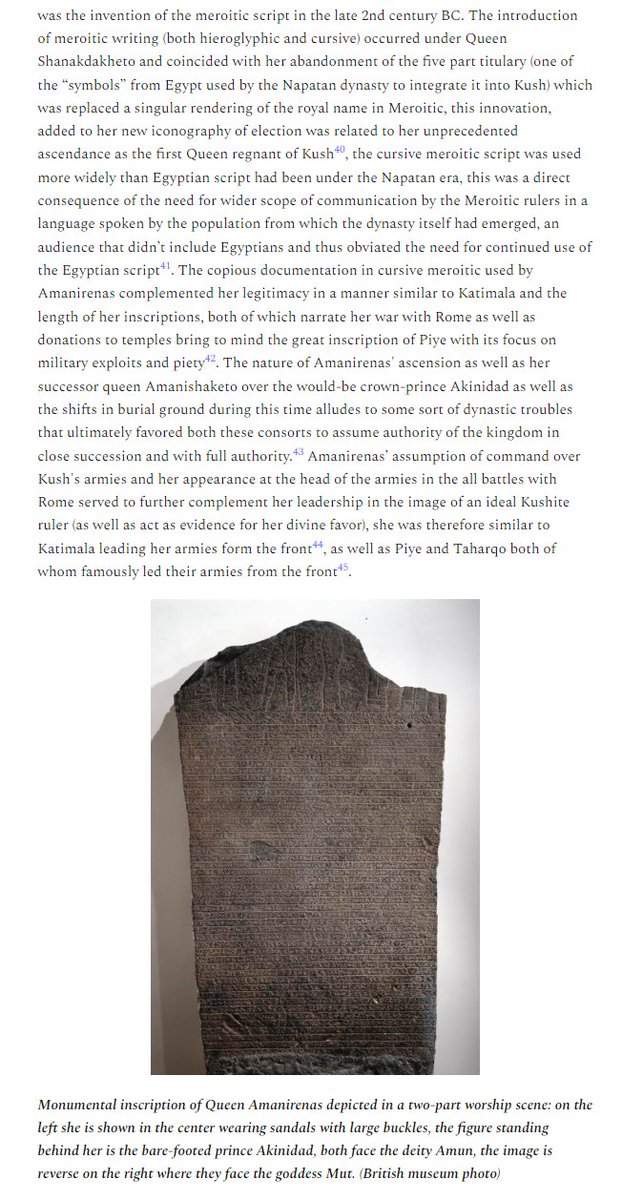
Queen Amanirenas ruled Kush at a pivotal time in its history
The nature of her enthronement set a precedent for her immediate successors and was part of the evolving changes in the Kush's ideology of kingship which enabled the rule of female sovereigns
isaacsamuel.substack.com/p/the-meroitic…
The nature of her enthronement set a precedent for her immediate successors and was part of the evolving changes in the Kush's ideology of kingship which enabled the rule of female sovereigns
isaacsamuel.substack.com/p/the-meroitic…
while the earlier Queens of Kush were "elected" by the prince, and afew ruled jointly with their husbands, the later Queens of the 2nd-4th century didn't require the legitimizing prince
and the regency of Queens was was now interpreted in its own terms
isaacsamuel.substack.com/p/the-meroitic…
and the regency of Queens was was now interpreted in its own terms
isaacsamuel.substack.com/p/the-meroitic…
Queenship in Africa was determined by ideology of rule in a given monarchy
similar to Ananirenas, Queen Njinga of Ndongo took on male attributes and battled the Portuguese
her momentous reign set a precedent for her successors, half of whom were women
isaacsamuel.substack.com/p/the-meroitic…
similar to Ananirenas, Queen Njinga of Ndongo took on male attributes and battled the Portuguese
her momentous reign set a precedent for her successors, half of whom were women
isaacsamuel.substack.com/p/the-meroitic…

a similar form of female sovereignty can also be seen in the creation of the queen mother offices; Iyoba in Benin kingdom and Magajiya in Kano city-state after the actions of those women
as well as the rise of elite women in Kongo's electoral council
isaacsamuel.substack.com/p/the-meroitic…
as well as the rise of elite women in Kongo's electoral council
isaacsamuel.substack.com/p/the-meroitic…
the dynamics of female sovereignty in Africa show that African conceptions of gendered authority were in flux enabling the rise of Queen regnants to the male office of King
Queen Amanirenas' overlooked accomplishment is the legacy of the Candaces of Kush
isaacsamuel.substack.com/p/the-meroitic…
Queen Amanirenas' overlooked accomplishment is the legacy of the Candaces of Kush
isaacsamuel.substack.com/p/the-meroitic…
• • •
Missing some Tweet in this thread? You can try to
force a refresh













